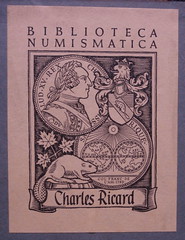
About UsThe Numismatic Bibliomania Society is a non-profit organization promoting numismatic literature. For more information please see our web site at coinbooks.org SubscriptionsThose wishing to become new E-Sylum subscribers (or wishing to Unsubscribe) can go to the following web page link MembershipThere is a membership application available on the web site Membership Application To join, print the application and return it with your check to the address printed on the application. Membership is only $20 to addresses in the U.S., $25 for First Class mail, and $30 elsewhere. For those without web access, write to: David M. Sundman, Treasurer AsylumFor Asylum mailing address changes and other membership questions, contact David at this email address: dsundman@LittletonCoin.com SubmissionsTo submit items for publication in The E-Sylum, just Reply to this message, or write to the Editor at this address: whomren@gmail.com BUY THE BOOK BEFORE THE COIN |
- WAYNE'S WORDS: THE E-SYLUM JULY 20, 2014
- WHITMAN OBSOLETE PAPER MONEY ENCYCLOPEDIA SELLS OUT
- NEW BOOK: ONLINE COIN AUCTIONEERING
- BOOK REVIEW: AMERICAN GOLD AND PLATINUM EAGLES
- LATEST SS CENTRAL AMERICA FINDS REVEALED
- THE FUJITSU SCANSNAP SV600 CONTACTLESS SCANNER
- NOTES FROM E-SYLUM READERS: JULY 20, 2014
- BURIAL COINS
- THE IMPORTANCE OF MEDAL PACKAGING MATERIALS
- THE NUMISMATIC MAGAZINE 1891
- FANCY FOOTWORK IN TRUMBULL'S DECLARATION PAINTING
- A CHOPMARKED 1799 DOLLAR
- QUERY: JAMES RUTLADER INFORMATION SOUGHT
- AUSTRALIA'S HOLEY DOLLAR AND DUMP
- THE JUDD-1140 PATTERN DOLLAR
- THE 1996 TREASURE ACT
- MACHINE FOR DETECTING COUNTERFEIT U.S. $100 BILLS
- DOGS FOLLOW THE SCENT OF MONEY
- FEATURED WEB PAGE: BRITISH EAST INDIA COMPANY
Click here to access the complete archive
To comment or submit articles, reply to whomren@gmail.com
WAYNE'S WORDS: THE E-SYLUM JULY 20, 2014

New subscribers this week include: Tom Denly, courtesy of Dave Bowers, Daniil Fishteyn, and Saeed Saif Almarri. Welcome aboard! We now have 1,743 subscribers.
This week we open with an update from Whitman Publishing, a new book and a review followed by new information on recent numismatic finds from the wreck of the SS Central America. Other topics include new scanning technology that could ease the digitization of numismatic books, burial coins, leather medals, and a chopmarked 1799 dollar.
To learn more about Charles Ricard, James Rutlader, online coin selling, ambrotypes, the value of cases, boxes and envelopes for packaging medals, the "Dustman" Farthing, the British East India Company and the scent of meney, read on. Have a great week, everyone!
Wayne Homren
Editor, The E-Sylum
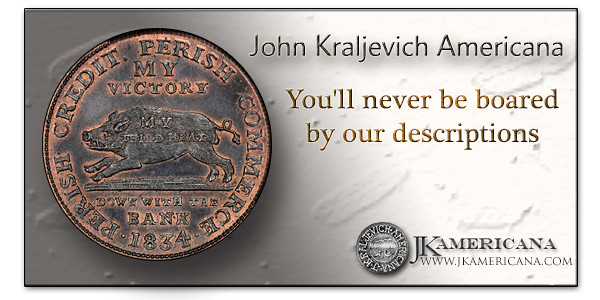
WHITMAN OBSOLETE PAPER MONEY ENCYCLOPEDIA SELLS OUT
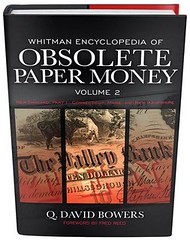 Whitman Publishing announces that volume 2 of its Whitman Encyclopedia of Obsolete Paper Money, released at the Memphis International Paper Money Show on June 12, 2014, has sold out as of July 17. Collectors can purchase the book from hobby shops and bookstores, including online, and the publisher has ordered a second print run to meet demand.
Whitman Publishing announces that volume 2 of its Whitman Encyclopedia of Obsolete Paper Money, released at the Memphis International Paper Money Show on June 12, 2014, has sold out as of July 17. Collectors can purchase the book from hobby shops and bookstores, including online, and the publisher has ordered a second print run to meet demand.
Whitman president Mary Burleson cited the hobby community’s growing interest in paper money, the reputation of well-known author Q. David Bowers, and word-of-mouth publicity at numismatic shows and club meetings as factors contributing to the strong demand and earlier-than-expected sellout.
“A sellout means that a book is temporarily out of stock from its publishing company,” said Whitman publisher Dennis Tucker. “Until our inventory is replenished, readers can buy the book directly from their favorite retailers.”
The Whitman Encyclopedia of Obsolete Paper Money is a study of currency issued from 1782 to 1866, before the modern era of National Banks and the Federal Reserve. Because more than 3,000 state-chartered banks issued their own paper money, the encyclopedia is expected to fill at least 12 volumes. Volume 2 is the first of three volumes that cover the New England states. In 752 pages it gives the history of every town and city as well as of every bank that issued this uniquely American currency in the New England states of Connecticut, Maine, and New Hampshire.
The encyclopedia’s author, Q. David Bowers, has compiled decades of research from 18th- and 19th-century bank reports, contemporary newspapers, and other primary sources. Each note is studied, and thousands are pictured in full color, with information on grading, rarity, values, significant auction results, advice for collectors, and more. To help create the encyclopedia, dozens of active collectors, researchers, dealers, historians, and other experts have volunteered their time and knowledge.
The 288-page volume 1, an introduction to obsolete paper money and an overview of the hobby, is still available from the publisher and has not yet sold out. It can be purchased online and from hobby shops and book retailers nationwide.
Future volumes will cover the Mid-Atlantic states, the American Midwest, the South Atlantic states, the District of Columbia, and territories.
Collectors and researchers interested in volunteering can contact Whitman Publishing at obsoletes@whitman.com. Volunteers will be credited in the books’ acknowledgments.
Collectors who want to learn more about the Whitman Encyclopedia of Obsolete Paper Money, and to meet Q. David Bowers in person, are invited to visit the American Numismatic Association World’s Fair of Money. At 2 p.m., August 7, 2014, Bowers and Tucker will present “Obsolete Paper Money: History, Rarity, and Today’s Market,” including an opportunity for questions-and-answers with the audience.
THE BOOK BAZARRE
NEW BOOK: ONLINE COIN AUCTIONEERING
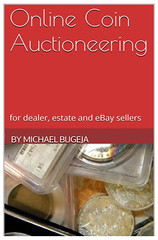 Numismatic writer and Citizens Coinage Advisory Committee member Michael Bugeja has assembled a new, updated work– Online Coin Auctioneering –intended for estate auctioneers considering or already selling on a portal such as AuctionZip, iCollector or Proxibid.
Numismatic writer and Citizens Coinage Advisory Committee member Michael Bugeja has assembled a new, updated work– Online Coin Auctioneering –intended for estate auctioneers considering or already selling on a portal such as AuctionZip, iCollector or Proxibid.
The advice in this new work also pertains to eBay and coin dealer auctions.
If you’re going to sell coins online, Bugeja writes, you have to understand Internet and other considerations that you must master to vend lots via a global platform. You also must become a numismatist rather than a hobbyist or estate auctioneer because you’re selling U.S. Mint and world mint products in raw condition or perhaps holdered by any number of companies. You must know how to grade, how to price, and how to describe lots. More important, you must master digital photography—the chief component of successful online sales. Finally, you have to know the business, from fake coins to dispute resolution.
This book covers it all. Written by nationally known numismatist Michael Bugeja, who writes for Coin World, reports for Coin Update News and is a member of the Citizen Coinage Advisory Committee of the US Mint, Online Coin Auctioneering is an indispensable guide.
To read the complete article, see: Michael Bugeja’s New Book Offers Tips to Sell Coins Online (www.coinweek.com/books-2/michael-bugejas-new-book-offers-tips-to-sell-coins-online/)
BOOK REVIEW: AMERICAN GOLD AND PLATINUM EAGLES
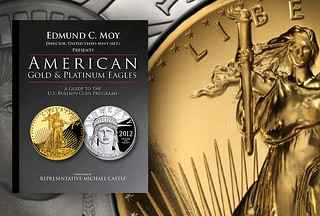 American Gold and Platinum Eagles: A Guide to the U.S. Bullion Coin Programs, by Edmund Moy
American Gold and Platinum Eagles: A Guide to the U.S. Bullion Coin Programs, by Edmund Moy
Edmund C. Moy, who served as Director of the U.S. Mint from 2006 to 2011, has probably had a greater impact on modern American coinage and numismatics than any other person who has run the Mint in the past several decades. His tenure there was especially consequential for coin collectors and bullion investors for two main reasons.
First, he served during an especially tumultuous period in the U.S. and world economies and in the precious metals markets, when silver and gold saw huge run-ups in their spot prices, demand for American bullion coins rose to new record levels as investors sought protection from the economic tumult of the day, and the Mint scrambled to produce enough coins and source the planchets to meet this feverish demand.
Second, Mr. Moy is a lifelong coin collector, and during his tenure at the Mint most of the key coin series that continue to this day got started such as the Presidential dollar, First Spouse gold coin, America the Beautiful quarter and five-ounce silver coin, and American Buffalo gold coin.
In addition, his period at the Mint is when the special finish versions of the American silver, gold, and platinum eagle coins and American silver and gold eagle anniversary coin sets began to be issued, and what is probably the single most popular collector coin issued in modern times was minted, namely, the 2009 Ultra High Relief gold double eagle.
Earlier this year Whitman Publishing published his book, American Gold and Platinum Eagles: A Guide to the U.S. Bullion Coin Programs, which includes a forward by Michael Castle (who co-authored the legislation that created the state quarter and American platinum eagle coin programs). The book is in many ways a companion to the 2012 book by John Mercanti and Michael Standish, American Silver Eagles.
Prior to the publication of Mr. Moy’s major reference work that takes readers behind the scenes while he was at the Mint and is aimed at a variety of audiences from coin collectors to bullion investors there was no book-length treatment of the subject. Coin guides such as Whitman’s famous “red book” have always had brief sections on the gold and platinum bullion programs, but they did not include detailed information or histories.
The book is notable not only for being the first reference work on the topic. It is also provides a revealing insider look at what was happening at the Mint during the important period when Mr. Moy ran it. The narrative chapters combine art, history, knowledge of coins and precious metals, and other areas in a way that will appeal to a wide audience.
However, some of the mintage information is listed incorrectly. For example, in the appendix on coin mintages for the American platinum eagle bullion and burnished coins the mintage data for the bullion coins issued in 2000 to 2008 is repeated in the table listing mintages for the burnished coins. But burnished platinum eagles were only issued in 2006-2008.
In addition, sometimes the most important points about certain year’s coins may get lost amid all the detailed information in the year-by-year study. Collectors and investors of the platinum collector coins consider the burnished and proof coins issued in 2008 to be major sleepers with good long-term value potential, as emphasized in Eric Jordan’s book, Modern Commemorative Coins, and in the book he co-authored with John Maben, Top 50 Most Popular Modern Coins.
Moy does discuss the fact that the coins sold poorly that year, which led to the discontinuation of the fractional proofs and all burnished platinum coins, but the importance of the 2008 coins, as both the lowest mintage of the entire platinum series, and as among the lowest of all modern U.S. coins along with some of the gold spouse coins, could have been discussed.
To read the complete article, see: First Read: American Gold and Platinum Eagles: A Guide to the U.S. Bullion Coin Programs (/www.coinweek.com/featured-news/first-read-american-gold-and-platinum-eagles-a-guide-to-the-u-s-bullion-coin-programs/)

LATEST SS CENTRAL AMERICA FINDS REVEALED
Deep-sea explorers recovered millions of dollars in gold and silver and a slew of personal items that are a virtual time capsule of the California Gold Rush, according to newly unsealed court documents obtained by The Associated Press that provide the first detailed inventory of a treasure trove being resurrected from an 1857 shipwreck at the bottom of the Atlantic Ocean.
The recovery effort at the SS Central America shipwreck, about 200 miles off the South Carolina coast, began in April and is expected to continue throughout the summer.
The new recovery operation was made possible after the court-appointed receiver awarded a contract to Tampa, Florida-based Odyssey Marine Exploration to conduct the recovery in hopes of bringing up more treasure and paying back investors.
The inventories, unsealed by a federal judge in Virginia late Wednesday, show that Odyssey Marine has brought up 43 solid gold bars, 1,300 $20 double eagle gold coins, and thousands more gold and silver coins.
Bob Evans, an Ohio scientist who was on both the original and current expeditions, said in a statement "the variety and quality of the coins being recovered is just astonishing."
He said the double eagles are just as "spectacular" as the ones recovered more than 25 years ago, but that the most recent recovery has resulted in a wider variety of coins.
"I have seen what I believe are several of the finest known examples," Evans said. "The coins date from 1823 to 1857 and represent a wonderful diversity of denominations and mints, a time capsule of virtually all the coins that were used in 1857."
The passenger items recovered from the Central America so far provide a window into the world of a California Gold Rush miner and other Americans who were on their way from The Golden State to New York when their ship sunk. Among them was a safe that contained two cotton pieces of clothing wrapped tightly around gold coins, nuggets, and dust, a pouch with 134 gold double eagles, a leather saddlebag with more nuggets, and a small packet filled with paper and sealed with twine.
Other items include wire-rimmed glasses, a gold puzzle ring, and the photographs of at least 60 passengers. The photos are called ambrotypes, a short-lived type of photography that used glass plates, and were left at the bottom of the ocean until Odyssey Marine can figure out how to safely recover them.
"Photographs of any mid-19th century Gold Rush miners are rare, and these ambrotypes are the only examples found on any 19th-century shipwreck worldwide," according to a court report by Odyssey Marine.
The inventories document what Odyssey Marine recovered at the shipwreck from the beginning of the operation on April 15 through June 15. An inventory of operations from the past month should be filed soon.
To read the complete article, see: APNewsBreak: Shipwreck's gold inventory released (www.wandtv.com/story/26045363/apnewsbreak-shipwrecks-gold-inventory-released)
To read the complete Daily Mail article, see: 43 gold bars, 1,300 double eagle coins and thousands of pieces of silver: Inventory of treasure worth MILLIONS of dollars revealed from 1857 shipwreck off South Carolina coast (www.dailymail.co.uk/news/article-2696319/Shipwrecks-gold-inventory-released.html)
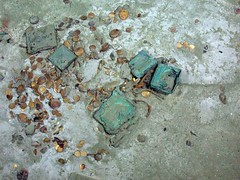
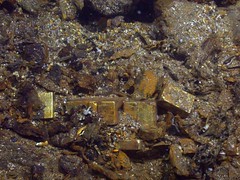
The inventories detail the items recovered to date, which include gold ingots, nuggets, dust and a wide variety of gold coins from $20 double eagles down through $10, $5, $2.50 and $1 gold coins, as well as California fractional gold, territorials and a wide variety of foreign gold. Additional significant cultural heritage artifacts have been identified and will be recovered.
RLP's chief scientist Bob Evans served as chief scientist on the 1988-1991 expeditions to the SS Central America and later as curator for the treasure recovered. As one of RLP's representatives on the project, Evans has been aboard the Odyssey Explorer since operations began in April 2014, cataloging the gold as it is recovered.
"The variety and quality of the coins being recovered is just astonishing," commented Evans. "Of course there are spectacular $20 double eagles like we found back in the 80s and 90s. But the wide variety of other denominations makes this year's recoveries very different from the earlier finds. I have seen what I believe are several of the finest known examples so far. The coins date from 1823 to 1857 and represent a wonderful diversity of denominations and mints, a time capsule of virtually all the coins that were used in 1857."
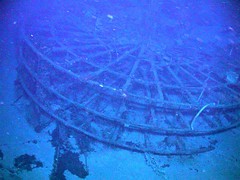 Odyssey President and Chief Operating Officer Mark Gordon added: "The operational reports filed with the court provide an overview of the activities conducted during each offshore period. The first two reports detail the pre-disturbance work and the recovery of items visible on the surface in the debris field, as well as initial archaeological excavation activities in the stern area of the shipwreck itself. The next report, which will be filed before July 25, will cover work conducted from mid-June to mid-July. As planned, during this period we made significant progress removing large amounts of coal and overburden to access certain areas of the shipwreck. We're looking forward to getting back to work at the site in the coming days."
Odyssey President and Chief Operating Officer Mark Gordon added: "The operational reports filed with the court provide an overview of the activities conducted during each offshore period. The first two reports detail the pre-disturbance work and the recovery of items visible on the surface in the debris field, as well as initial archaeological excavation activities in the stern area of the shipwreck itself. The next report, which will be filed before July 25, will cover work conducted from mid-June to mid-July. As planned, during this period we made significant progress removing large amounts of coal and overburden to access certain areas of the shipwreck. We're looking forward to getting back to work at the site in the coming days."
To read the complete article, see: Odyssey Recovers SS Central America Shipwreck Treasures (www.maritime-executive.com/article/Odyssey-Recovers-SS-Central-America-Shipwreck-Treasures-2014-07-18)
THE FUJITSU SCANSNAP SV600 CONTACTLESS SCANNER
 Regarding Les Citrome's article, I thought I should let E-Sylum readers know about a reasonably new scanner that has been released by Fujitsu that allows for non-destructive scanning of many bound documents, the ScanSnap SV600 Contactless Scanner.
Regarding Les Citrome's article, I thought I should let E-Sylum readers know about a reasonably new scanner that has been released by Fujitsu that allows for non-destructive scanning of many bound documents, the ScanSnap SV600 Contactless Scanner.
You can read more information about it here: Fujitsu ScanSnap SV600 Contactless Scanner (www.fujitsu.com/us/services/computing/peripherals/scanners/scansnap/scansnap-SV600.html)
There are a range of videos that demonstrate how it works: ScanSnap SV600 (www.youtube.com/watch?v=wJ4exzkxXzg)
As you can see, the scanning takes just seconds. The software that accompanies the scanner straightens the curved scanned images so they are as required for reading, and also OCR’s the scanned information, enabling text searches etc.
I’ve used it to scan sections from a number of books and journals relevant to my recent numismatic research, and can confirm that it works extremely well.
I’m presently liaising with several members of the Australian numismatic fraternity of how a number of these scanners, in the hands of volunteers around the country, might allow us to finally digitise the published numismatic literature in Australia. Ideally, that would then be added to a searchable, online database of some kind.
It remains a large project, however at least this new technology allows it at a price that is affordable to volunteer associations etc.
To read the earlier E-Sylum article, see: LES CITROME ON DIGITIZING A PROFESSIONAL LIBRARY (www.coinbooks.org/esylum_v17n29a14.html)
NOTES FROM E-SYLUM READERS: JULY 20, 2014
Paweù Niemczyk Andy Singer writes:
A Polish colleague has died accidentally. Please see the link below. The article is in Polish, the only one I could find. Sorry to hear these things.
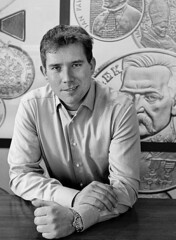 Like Andy, I used Google Translate to get the gist of the article in English, but also confirmed the result with E-Sylum contributor Gosia Fort, a native of Poland. Thanks! Apparently ...
Like Andy, I used Google Translate to get the gist of the article in English, but also confirmed the result with E-Sylum contributor Gosia Fort, a native of Poland. Thanks! Apparently ...
... he was participating in a fishing competition. He fainted and fell into the water and could not be revived despite the immediate effort to resuscitate him before the ambulance arrived.
To read the complete article, see:
Odszedù Paweù Niemczyk
(omonetach.pl/aktualnosci/1/9012/odszedl-pawel-niemczyk)
More on the 100 Ruble Note Picturing Apollo Statue Regarding that Russian banknote discussed last week, Kavan Ratnatunga writes:
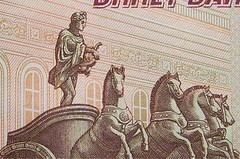 What is not stated is that this 100 Ruble Note was first issued in 1997 and has been in circulation for 17 years.
A newer 100 Ruble Commemorative note was issued for the 2013 Winter Olympics. Anyway, I Purchased one on eBay just in case it becomes a high value Collectible :-)
What is not stated is that this 100 Ruble Note was first issued in 1997 and has been in circulation for 17 years.
A newer 100 Ruble Commemorative note was issued for the 2013 Winter Olympics. Anyway, I Purchased one on eBay just in case it becomes a high value Collectible :-)
To read the earlier E-Sylum article, see: RUSSIAN LAWMAKER WANTS APOLLO'S GENITALS REMOVED (www.coinbooks.org/esylum_v17n29a25.html)
Doyen of Numismatics? Regarding the discussion about the title Dennis Tucker applied to Q. David Bowers, Jim Duncan of New Zealand writes:
How about DOYEN of numismatists?
To read the earlier E-Sylum article, see: Q. DAVID BOWERS, 'DEAN OF AMERICAN NUMISMATICS' (www.coinbooks.org/esylum_v17n29a11.html)
Query: Hardcover Merkin 7th Auction Sale Sought David Fanning would like to hear from anyone owning a hardcover edition of Lester Merkin's seventh auction sale (Mar. 6-7, 1968). He can be reached at df@numislit.com. Thanks.
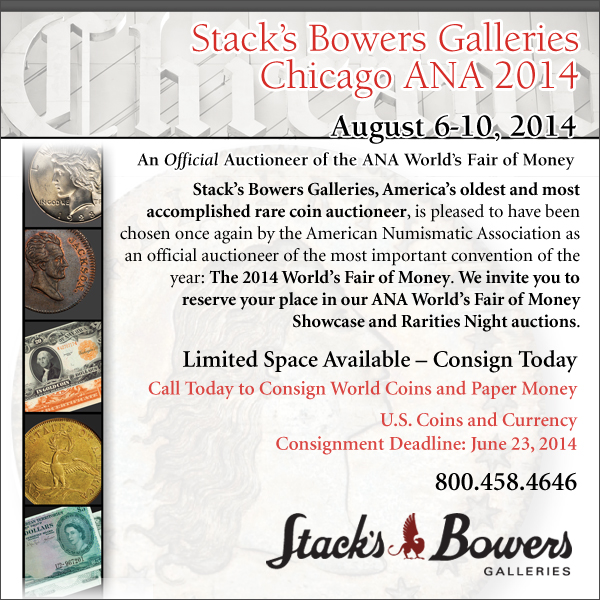
BURIAL COINS
David Pickup writes:
I went to a symposium in York recently mainly about early medieval coins. One talk was on burial coins. It made we wonder what coin I would like to be buried with. Coins seem to have been buried with people to demonstrate status rather than for use in the afterlife. I think I would either go for a pound coin as i can never find one when I need one to use in the supermarket trolley or a pre decimal penny. Although low in value the Britannia figure is high in status and much missed on today's coins.
Regarding Paul Sherry's September 23, 2007 E-Sylum submission, web site visitor Robert Ward writes: "I came across your article while Googling ‘Robert Mylne’, whose biography I recently wrote. It was published in April 2007 and might interest your readers.
"It also relates the previously unpublished events concerning Nelson’s burial. Briefly Robert Mylne, who as cathedral surveyor of St Paul’s was responsible for constructing the tomb, agreed with Matthew Boulton to make a secret deposit of some of Boulton’s coins and medals under Nelson’s coffin."
"Surviving correspondence between Mylne and his longstanding friend Boulton, which had lain unnoticed among Boulton’s papers for two centuries, describes this extraordinary plan in detail. Mylne asked for ‘a compleat Series of all you have ever done ... even to farthings’ and explained that his motive was ‘to bury your Glories for the instruction and admiration of future times, what was done in this Country in these times; along with the Glories of the Greatest Seaman and Warior that has ever existed...’
"Boulton in turn proposed that the coins and medals should be laid in the tomb in pulverized glass between sheets of plate glass enclosed with a frame of slate or marble, explaining that ‘the principle of preservation of Metals is perfect exclusion from air and moisture’.
"If, as seems likely, Mylne’s deposit is still in place, it must rank as one of the most tantalising of buried treasures. Under the hero’s coffin in the base of a massive granite tomb in St Paul’s crypt, precisely under the centre of the cathedral’s dome, it is safe from all interference - a time capsule awaiting the arrival of some archaeologist from the remote future, just as Mylne intended."
To read the earlier E-Sylum article, see: ROBERT MYLNE AND THE LONDON BLACKFRIARS BRIDGE CORNERSTONE MEDALS (www.coinbooks.org/esylum_v10n47a10.html)
THE IMPORTANCE OF MEDAL PACKAGING MATERIALS
Medals are issued in cases, boxes and envelopes. For years I have mentioned to collectors not to discard these. This important fact became evident this week when I was researching a rather scarce so-called dollar.
Cases often contain a name not found on the medal, sometimes even printed on the satin liner inside the case. Envelopes often contain more data than the name of the medal. Boxes seldom reveal such information.
In Joe Levine's auction catalog #78 (June 7, 2008) appeared an illustration of the Louisiana Centennial Medal (HK 396) with the box in which it was issued. Bottom line on the top of the box was a tiny line, "Coleman E. Adler, Maker, N.O." That triggered a research effort.
The first place I looked was my own databank of American artists of coins and medals. Sure enough, I found a single entry to Coleman E. Adler. He had a state seal relief cast at Gorham in 1909. He issued the HK medal in 1912. Can we assume that state seal relief was Louisiana -- and that was the image on the obverse of the centennial medal?
When I entered that entry from Gorham archives I searched the usual artists directories without luck. So now I turned to Google -- what better starting place for any research effort -- to learn that Adler Coleman was the name of a jewelry firm in New Orleans.
Searching deeper I found Coleman Adler's obituary: born in Slovakia January 10, 1868, Came to America 1897, opened a jewelry store in New Orleans in 1898. He issued the Louisiana Centennial Medal in 1912. He died February 17, 1938.
So we can conclude his jewelry firm commissioned someone (unknown artist) to prepare that model that Gorham cast in metal. He then had medals made -- not by striking -- but as Joe Levine reveals all were electrotype casts. It is a scarce medal today and obviously that is why Hibler and Kappen did not illustrate it in their 1963 classic book on So-Called Dollars. (Had they found one they may not have included it since it was not diestruck.)
However that is not the end of the story. In 2012 the Coleman Adler firm issued a bicentennial medal for Louisiana's 200th statehood anniversary. So Coleman Adler should be considered a publisher or issuer of the medal, not the artist, for both medals.
A mystery solved because someone saved the box the medal came in that ended up in Joe's auction.
THE BOOK BAZARRE
THE NUMISMATIC MAGAZINE 1891
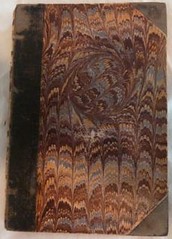
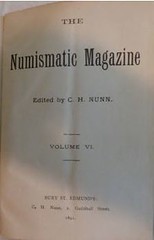
The Numismatic Magazine, edited by C. H. Nunn, volume 6, 1891, complete year, bound, backstrip missing, some pages loose. Articles include death of L. C. Wyon, listing of Queen Victoria Jubilee medals, and English silver tokens and ads for various coins and medals.
To read the complete eBay lot description, see:
THE NUMISMATIC MAGAZINE 1891 COMPLETE YEAR BOUND
(www.ebay.com/itm/THE-NUMISMATIC-MAGAZINE-1891-COMPLETE
-YEAR-BOUND-/121380082076)
Calvin adds:
It has a bookplate by owner "Charles Ricard"(Biblioteca Numismatica--with beaver on stump, King Charles XV coin, lion in shield, and a French coin from 1753). Very cool bookplate. The index includes:
- Accington Political Medal, An
- African Coins, Recent
- Bank of England Note, Stopping a
- Birbeck Building Society
- British Coins for 1891
- Cashmere Half Rupee, A
- Chinese Coins
- Coins, A rare
- Coinage, Proposed new gold & silver
- Coiners, counterfeit
- Coins, Ancient, Forgeries of
- Coins, Countermarked
- Coins, Discovery of ancient
- Coins, 2 with histories
- Coins, strange discovery of
- Consular Denarii, Notes On
- Correspondence--& answers to
- Discovery, singular
- "Dustman" Farthing
- Errata
- Florin, Reign of Victoria,
- Three types of Fourpenny piece for British Guiana & West Indies Groats,
- Analysis of a parcel of Heaton,
- Death of Mr. Ralph Koch, Dr.,
- Medal of Leather Money Medal, Peace of 1814 (Fereday's)
- Medal Commemorative of visit of the Emperor and Empress of Germany
- Medal, Blackpool Tower
- Medal, Dudley Medalets, some common political Mint in the early 18th century,
- The Mint,
- The Money New Year's Greeting
- Numismatic curiosity
- Numismatic Exchange
- Numismatic Notes
- Numismatic Society, Proposed
- One Pound Notes
- "O.P Medal, Another O.P. Medal, a 3rd
- Parliment, and the currency Penny Piece,
- A Singular Psuedo-Numismatic Waifs,
- Some Queries Replies to Queries
- Roman Coins
- Roman Coins, Articles on Roman Coins, old works on Roman Coins, undescribed by Cohen,
- Some Sales of Coins Medals, etc (OMG..THE PRICES!!!!)
- Sale of the Capo Cabinet Shakespeare,
- Medal of Sheckel, the Holy Silver Coins,
- New Silver Tokens not in Boyne's works
- Tobago, Coins used in
- Token, First private, of the 18th Century, and it's counterfeit
- Two Hundred guineas for one schilling Union of Great Britain and Ireland,
- Medal Commemorating Victoria Jubilee
- Medal William III, Crown, blundered
- Wyon, Death of Mr. L.C.
My father placed these bookplates in many of the volumes that he owned over the years. It is his original design, and includes the beaver, which appears on the Ricard Family Canadian Coat of Arms. The Charles coin was for his first name, the beaver represents our Canadian ancestors who were fur traders, and the French graphics for our origins near Marseilles.
Leather Money
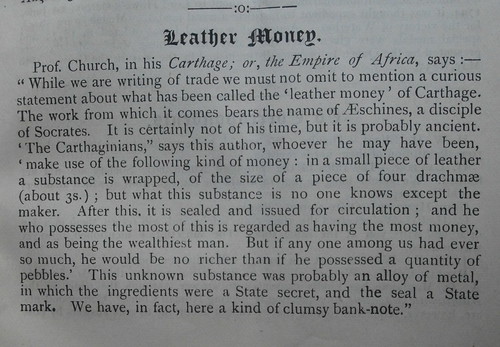
The "Dustman" Farthing
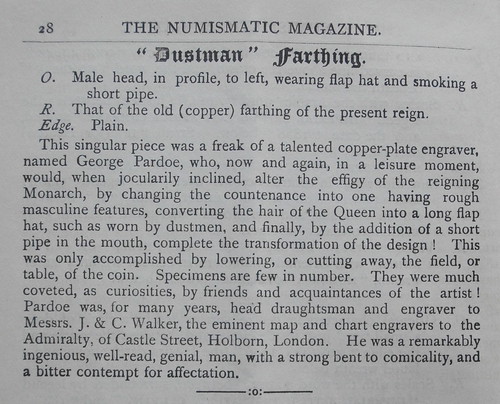
Calvin adds:
I tried Googling the "Dustman Farthing", and, all kinds of variations, all to no avail. I did pull up a "hobo" style 1d, but it's probably modern. I'd give an eye tooth to find a real 1890 hobo farthing from George Pardoe.
FANCY FOOTWORK IN TRUMBULL'S DECLARATION PAINTING
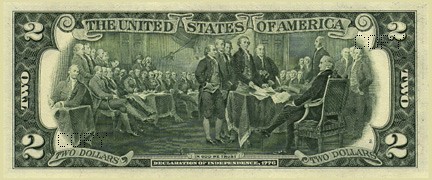
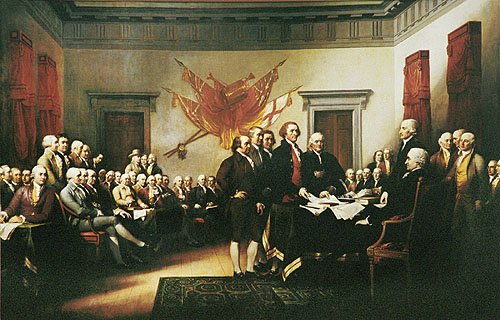
Paul writes:
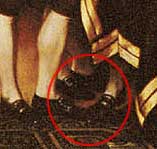 I was looking for something juicy, like an explanation of the "extra foot" in the vignette and painting. Didn't happen! I always thought that the original "foot" was a table foot and not a human foot. I think the engraver imagined a human foot and simply embellished it on the engraving. But that begs the question of what about the "foot" under the corner nearest the viewer!
I was looking for something juicy, like an explanation of the "extra foot" in the vignette and painting. Didn't happen! I always thought that the original "foot" was a table foot and not a human foot. I think the engraver imagined a human foot and simply embellished it on the engraving. But that begs the question of what about the "foot" under the corner nearest the viewer!
I never did think much of a Jefferson foot on an Adams' foot. What possible reason would cause Jefferson to do that? Did they get caught doing some "footsie?"
For more information, see: John Trumbull's "Declaration of Independence, July 4, 1776" (www.ushistory.org/declaration/trumbull.htm)
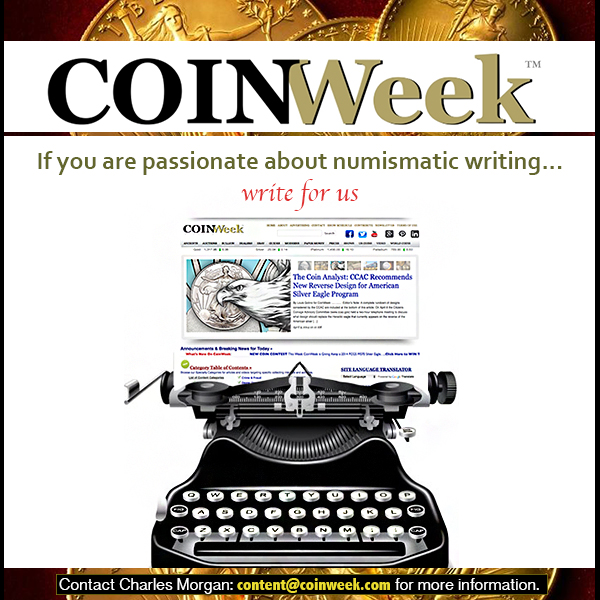
A CHOPMARKED 1799 DOLLAR

USA 1799 One Dollar, KM-32, R-3. The British Museum collection. The coin was donated to the museum by CCC member William Barrett in 1997. Mr. Barrett has donated a total of 1,313 items to the museum. I emailed Mr. Barrett about the coin and he told me that he acquired it at Jeff Hoare Auctions, October 27, 1996, for about C$250 [about US$185 at the time].
To read the complete British Museum inventory listing, see:
coin
(www.britishmuseum.org/research/collection_online/
collection_object_details/collection_image_gallery.aspx?
assetId=1390784&objectId=3276692&partId=1)
QUERY: JAMES RUTLADER INFORMATION SOUGHT
The May-June issue of Token and Medal Society Journal has an article on World War II naval chits from Ceylon, one of which is rubberstamped on the back: JAMES RUTLADER / KANSAS CITY, MO. The author, Gary Ascher, is asking for more information. I recognized the name Rutlader, because he issued brass tokens and because he was a coin dealer. This is what I have pieced together.
James Rutlader (born 1921 in Cleburne, TX and still living in 2007) in 1938 lived with his father, Harry Rutlader (1889-1961), and his brother, Joseph H. Rutlader (1913-1987, born in Poland), at 1418 Wabash Avenue, Kansas City. James and his father ran Good Luck Furniture Company (used furniture) at 1120-1124 E. 15th Street. Brother Joseph ran the Ace Mattress Company (also used furniture) a few blocks down the street at 820 E. 15th.
In the 1940 census they were all still living on Wabash. In 1951 Good Luck Furniture was still at the same address, though the street had been renamed Truman Avenue, and Ace Furniture Company (new name) had moved to 1013 Truman. Good Hope Furniture was still operating at the same address as late as 1962.
Meanwhile, James Rutlader had written a book, Allied Military Currency from World War II, which was published in Kansas City in 1968. The book was available from the author at that time at 1122 Truman Road -- which is the Good Luck Furniture Company address. By 1984, he was in the coin business, operating as Rutlader Coins & Stamps (or Rutlader Company) at 8255 Wornall Road (according to the phone directory).
Good Luck Furniture does not appear to have been in business at that time, but Ace Furniture was open at 6257 State Avenue. About 1990, Rutlader donated 125 acres of land, located southwest of Kansas City, just over the state line in Kansas, to the state of Kansas and this became the Rutlader Wildlife Area. Nearby, 7 miles south of Louisburg, Kansas, he developed a 25 acre complex known as Rutlader Outpost, where he built an old western town, building by building.
I want to know if any readers remember James Rutlader as a coin dealer. Was he really in the coin business, or did his used furniture business turn into an antique store? When and for what purpose did he have the brass tokens (5 and 50 cent and $1) made? Were they used for the furniture store or his coin business or did he have some other sideline business?
I also found in my collection an undated one ounce .999 silver round issued by Rutlader, with an obverse design imitating a Morgan dollar. When was this made? I suspect his parents were Jewish refugees from Poland; is this correct? Did James Rutlader serve in the military during World War II? Why is his name stamped on the back of the Ceylon naval scrip? I will be happy to pass on further information to Gary Ascher.
THE BOOK BAZARRE
AUSTRALIA'S HOLEY DOLLAR AND DUMP
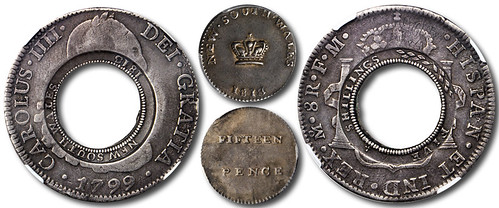
The first coins issued in what is now the Commonwealth of Australia were issued out of necessity, using the internationally useful Spanish colonial silver 8 reales as host. The centers of the eight reales were punched out, and around the hole, were inscribed NEW SOUTH WALES 1813 on the obverse side, and FIVE SHILLINGS with a wreath on the reverse.
The large hole in the center of the coin led to the nickname of “Holey Dollar,” and the moniker has stuck. The central punched out portions were not wasted as they were struck with a simple FIFTEEN PENCE on the obverse and crown in the center with NEW SOUTH WALES above and 1813 below on the reverse. These 15 pence coins became known as “dumps.” Having a pairing of a “Holey Dollar and Dump” in one sale is a rare opportunity for specialists.
AUSTRALIA. New South Wales. 5 Shillings or "Holey Dollar", 1813. NGC VF-30. KM-2.9; Mira/Noble-1799/7 (plate coin); Spalding-81.
EXCEPTIONAL RARITY with a distinguished pedigree. Part of the first series of coins minted for, and in, the British settlement of New Holland "Australia". Struck in 1813 and issued in 1814, during the governorship of Lachlan Macquaire. Described by Mira and Noble in their standard reference as "Pride of place in any collection of Australian colonial coinage". This RARE issue circulated for a short period of time as they were recalled in 1829 when they were ordered to be replaced with "English Specie" which brought their circulation to an end. The recalled coins were shipped to the Royal mint where the bulk of the original issue of almost 40,000 was melted down. Dies: I/5: A/4 (Spalding 81).
The countermarks are sharp and clear for both the obverse and the reverse. The central hole was not fully punched out in one quarter (slightly off center), and some minor amount of metal remains within the punched out hole.
Ex: A. Thellusson Collection, Sotheby's October 1931, lot #403. Ex: C.C. Browne Collection, Sotheby's March 1935, lot #564. Ex: Major A. Foster Collection, Glendinings October 1953, lot #22. Ex: G.E. Hearn Collection. Ex: K. Frost Collection Sold Max Stern & Co., November 1976, lot #226. Ex: Roy Brook Collection, P.J. Downies September 1978, lot #351. Ex: Spink Australia Sale 24, March 1988, lot #1041. Ex: P.F. Worth Collection.
To read the complete article, see:
“Holey Dollar and Dump” Major Highlights of Stack’s Bowers Official Auction of the ANA World’s Fair of Money in Chicago
(www.stacksbowers.com/NewsMedia/Blogs/TabId/780
/ArtMID/2678/ArticleID/64609/)
THE JUDD-1140 PATTERN DOLLAR
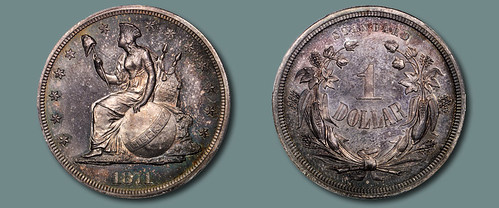
The 1871 pattern “Standard Silver” dollar, attributed as Judd-1140, Pollock-1282, is rated as Rarity-8, with only two known specimens. The design type features Liberty dressed as an Indian, seated on a globe holding a pole with a liberty cap. The reverse shows the denomination within a cereal wreath, and the word STANDARD above. Nowhere on either side is the name of the country of origin noted, an interesting feature.
“While the extreme rarity of this type has long been recognized, the existence of two examples in numismatic hands remained unknown until the present sale, and for a very simple reason. The coin we are offering here has been off the market for more than 40 years, having last appeared at auction in Kagin's Sale of the '70s. Since that event, conducted in November 1973, only one other example of Judd-1140 has been offered for sale -- the Farouk specimen that reappeared in Spink Smythe's May 2011 sale of the Magnolia Collection.
To read the complete article, see:
Extremely Rare Judd-1140 Pattern Dollar
(www.stacksbowers.com/NewsMedia/Blogs/TabId/780/ArtMID/
2678/ArticleID/64611/Extremely-Rare-Judd-1140-Pattern-Dollar.aspx)
THE BOOK BAZARRE
THE 1996 TREASURE ACT
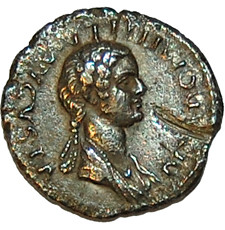 Generally if you get two or more coins they are treasure. But if you get a single one it’s not classed as treasure.
Generally if you get two or more coins they are treasure. But if you get a single one it’s not classed as treasure.
A person came in to Bristol Museum, realised he’d made quite a find and just wanted to get it recorded. He was a metal detectorist: it was found on ploughed land.
About 80 percent of our finds come from detectorists, but not always – sometimes people have been digging their back garden or have gone field walking, looking for pottery or flint, things like that.
The legal perspective is that anything you find is the property of the landowner. As long as you’ve got permission from them to remove the finds then that’s fine.
We assume people have got permission: we can’t go checking everyone up. If it’s not treasure we simply give it back to them.
We borrow it for a little while so we can accurately record it.
In many cases I research them as well, going through the books to make sure we’ve got the right dates and information. We also photograph it.
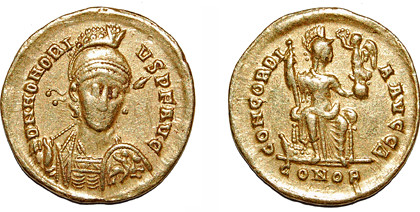
We assume it’s the only time an archaeologist is going to see it, so you have to get as much information as possible.
If it’s treasure it falls under the 1996 Treasure Act. You’ve got very specific criteria about things that aren’t treasure.
With coins, if it’s gold or silver there’s got to be two or more of them, and they’ve got to be over 300 years old.
If it’s copper alloy there have got to be ten or more of them. If it’s prehistoric any part of it can be gold or silver to make it treasure.
The great thing about the Treasure Act is that it’s trying to keep some of the best artefacts in the hands of the nation.
A great example of where the system failed the nation, if you like, was with the cavalry helmet in Cumbria.
That’s not treasure, but it’s an enormously important artefact nationally. But because we weren’t able to protect it, it just got sold into private hands.
The whole aim of the Act is to ensure that these really important items are kept in the national collections. Because they’re in a museum they stay in the public domain.”
To read the complete article, see: Festival of Archaeology 2014: Roman gold coins and daggers of war in the west (www.culture24.org.uk/history-and-heritage/archaeology/art491102-Festival-Archaeology-Roman-gold-coins-daggers-war-west)
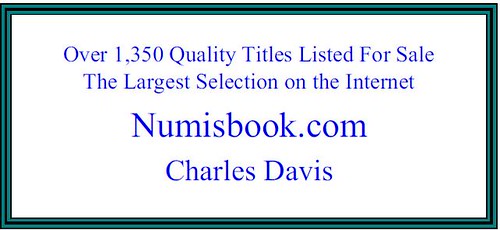
MACHINE FOR DETECTING COUNTERFEIT U.S. $100 BILLS
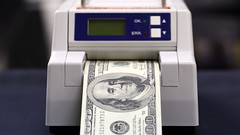 The latest generation of counterfeit U.S. hundred dollar bills are so close to the real thing they are impossible to detect with the human eye. Yoshihide Matsumura’s machines catch them.
The latest generation of counterfeit U.S. hundred dollar bills are so close to the real thing they are impossible to detect with the human eye. Yoshihide Matsumura’s machines catch them.
Using ultraviolet and infrared rays as well as magnetic field sensors, the founder of Matsumura Engineering Co., is targeting the fake U.S. bills that are popping up in countries from South America to Asia and the Middle East.
Matsumura calls the new counterfeits “Super S,” which stands for “super special”. They’re a forgery of the Series 1996-2003A $100 note that features an image of Benjamin Franklin. The Series 2009A $100 notes introduced in October 2013 have a 3-D security ribbon making them more difficult to fake.
“Humans can't identify the new counterfeit bills and most of the detectors used in financial institutions are useless against them” says Matsumura. “The paper and ink used for the counterfeit bill are almost the same as genuine ones.”
Matsumura, who also works as a counterfeit advisor for law-enforcement agencies in Japan and the U.S., first detected the new counterfeits last fall. He coined the term for a previous generation of counterfeits known as “Super K” – they likely originated in North Korea.
To read the complete article, see: Japanese Inventor Says His Machine Can ID Even the Best 'Super S' $100 Counterfeits (www.bloomberg.com/news/2014-07-16/japanese-inventor-says-his-machine-can-id-even-the-best-super-s-100-counterfeits.html)
DOGS FOLLOW THE SCENT OF MONEY
Money has no smell? That is what the Roman emperor Vespasianus is said to have answered his son who disapproved of the new tax on the use of public toilets. Today we know: Maybe it does not stink but it actually has a proper smell. And we can train dogs to it!
In 2012 the French police dog Fury discovered more than 200,000 euros hidden in a chimney. Recently five-year old Enya of the Rennes canine unit was involved in another spectacular operation. She found 186,000 euros and was decorated for that success together with her dog handler.
For quite some time the quadrupeded police officers have assisted their human colleagues sniffing drugs. Since some years Banque de France has been supporting the formation centre of the canine units of the French police with drilling the dogs to find hidden money.
In the premises of Banque de France young dogs faced samples of chaffed banknotes whose odour they memorised. At the same time the experts analysed what was so peculiar in these banknotes that the animals were able to distinguish it. Now we know: the ink and the paper.
Thereupon the training was significantly simplified. Today Banque de France sends only odourant molecules of ink and paper in glass tubes to the training centre. With these substances the dogs learn just as well as the outcome proves.
To read the complete article, see: New Success of Money-tracking Dogs (www.coinsweekly.com/en/News/4?&id=2901)
FEATURED WEB PAGE: BRITISH EAST INDIA COMPANY
This week's Featured Web Page is from the Fitzwilliam Museum web site, on the coinage of the British East India Company.
In AD 1600, the East India Company was founded and set up trading settlements on the coast of India, known as 'factories', At first they used silver coins from the New World, but were not accepted elsewhere in India, so an agreement was reached for the Company to send its bullion to the Mughal mint in Surat. By 1672 the Company had established a mint in Bombay to produce copper and tin coins to serve its local needs and in 1717 they started minting silver rupees of Indian style in the name of the emperor. These became the principal currency for West Indian trade. A mint was also established in Madras, where they produced copper coins, silver rupees and their most distinctive coinage, gold 'pagodas'.
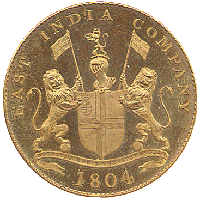
www.fitzmuseum.cam.ac.uk/gallery/East-West/India_1.html

